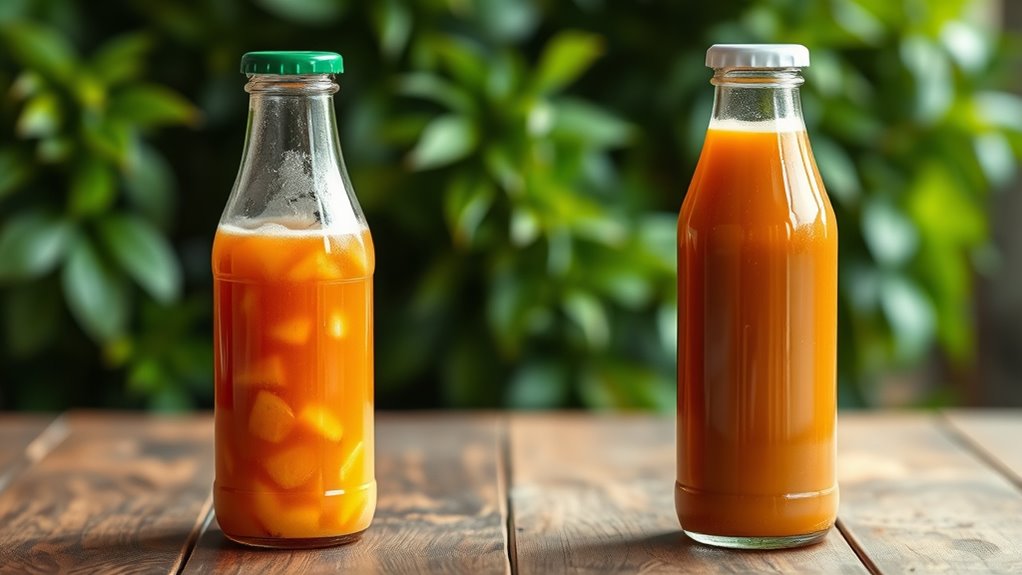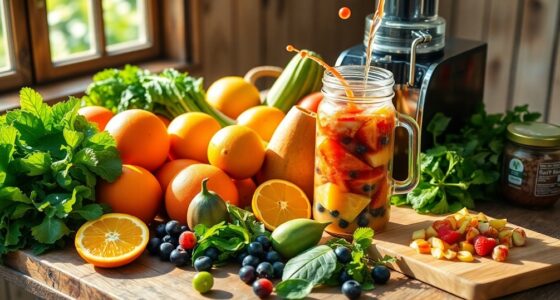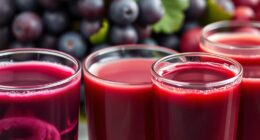When choosing between raw and pasteurized organic juices, consider your priorities: raw juices retain more enzymes and nutrients but carry a higher risk of microbial contamination, requiring careful handling. Pasteurized juices offer enhanced safety, longer shelf life, and consistent flavor, though they may lose some nutrients during processing. Balancing safety with nutrition depends on your preferences and needs—exploring further reveals how each option aligns with your health and lifestyle choices.
Key Takeaways
- Raw organic juices preserve maximum enzymes and nutrients but have a higher risk of microbial contamination.
- Pasteurized organic juices undergo gentle heat treatment, reducing microbial risks while slightly decreasing nutrient levels.
- Raw juices offer authentic flavor and freshness, whereas pasteurized juices have a longer shelf life and better safety profile.
- Consumers seeking minimally processed, nutrient-rich options may prefer raw juices; others prioritize safety with pasteurized options.
- Both raw and pasteurized organic juices can be healthy choices, depending on safety concerns and nutritional priorities.

When choosing organic juices, understanding the differences between raw and pasteurized options is essential. These choices directly impact your health, especially concerning nutritional integrity and microbial safety. Raw organic juices are processed without heat, meaning they retain most of their natural enzymes, vitamins, and minerals. This preservation of nutrients appeals to those seeking the most authentic and minimally processed product. However, raw juices carry a higher risk of microbial contamination because they haven’t undergone any heat treatment to eliminate harmful bacteria, yeasts, or molds. If you’re someone who cares about maintaining maximum nutrient levels and prefers a more natural product, raw juice might seem attractive. But you need to be aware of the potential safety concerns, especially if you’re immunocompromised or serving others who may be more vulnerable.
Raw organic juices retain more nutrients but pose higher microbial risks; choose based on safety and nutrition priorities.
On the other hand, pasteurized organic juices undergo a gentle heat treatment to kill harmful microbes, markedly enhancing microbial safety. This process reduces the risk of foodborne illnesses, making pasteurized juices a safer choice for many consumers. While some argue that pasteurization can diminish certain nutrients and enzymes, modern techniques aim to preserve as much nutritional integrity as possible. You still get a product that’s rich in vitamins and antioxidants, but with the added reassurance that it’s been tested for safety. This is particularly important if you’re buying juice for children, pregnant women, or anyone with a weakened immune system. Pasteurized juices tend to have a longer shelf life due to their reduced microbial load, making them more convenient for storage and transportation. Additionally, the use of high-quality pasteurization methods helps minimize nutrient loss, ensuring a better balance between safety and nutrition.
While raw juices provide a more ‘living’ product, they often require careful handling, refrigeration, and quick consumption to prevent spoilage. If you choose raw, you should source from reputable providers who follow strict hygiene standards, knowing that you’re getting a product that’s as safe as possible. Conversely, pasteurized juices give you peace of mind with their microbial safety, but some argue that the heat process can compromise the fresh, vibrant flavor and slight nutrient loss. Still, many consumers consider the safety benefits worth the minor trade-offs in texture and flavor.
Ultimately, your decision depends on your priorities—whether you’re willing to accept a slight reduction in microbial safety for maximum nutritional integrity, or if you prefer the added safety and longer shelf life of pasteurized options. Both types can be organic and healthy, but understanding these key differences helps you make an informed choice that aligns with your health goals and safety concerns.
Frequently Asked Questions
How Does Pasteurization Affect Juice Nutrient Levels?
Pasteurization can cause nutrient degradation in juice because heat sensitivity affects many vitamins, especially vitamin C and certain antioxidants. As you heat the juice during pasteurization, some nutrients break down, reducing their levels. While it helps eliminate harmful bacteria and extends shelf life, it does compromise the juice’s nutritional content. So, if you’re after maximum nutrients, raw juice might be better, but pasteurized juice offers improved safety and longer freshness.
What Are the Taste Differences Between Raw and Pasteurized Juices?
You’ll notice that raw juices burst with flavor intensity and have a lively, fresh taste, like biting into the fruit itself. Pasteurized juices, on the other hand, tend to have a milder, sometimes slightly cooked flavor, with subtle texture variations due to heat processing. Raw juices keep that vibrant, natural zing, while pasteurized ones offer a smoother, more consistent experience—almost like the difference between a wild berry and a processed one.
Are Raw Juices More Prone to Microbial Contamination?
Yes, raw juices are more prone to microbial risk because they haven’t been pasteurized to eliminate harmful bacteria. This increases the chance of contamination, especially if proper contamination prevention practices aren’t followed during handling and processing. To reduce risks, you should always buy from reputable sources, store juices correctly, and consume them quickly. Being aware of these factors helps you enjoy raw juices safely while minimizing health concerns.
How Long Do Raw Juices Typically Last Compared to Pasteurized?
If you’re wondering about shelf life, raw juices usually last 1-3 days, while pasteurized ones can stay fresh for up to two weeks. To preserve their quality, store them in cold, airtight containers, and keep them refrigerated. Raw juices are more delicate, so they require prompt consumption and careful storage to minimize spoilage. Pasteurization extends shelf life, giving you more flexibility and peace of mind with storage.
Is There a Significant Price Difference Between Raw and Pasteurized Juices?
You’ll notice a pricing disparity between raw and pasteurized juices, with raw versions often costing more due to higher production costs and perceived quality. Consumer preferences influence this price difference, as many people value raw juices for their natural nutrients and flavor, willing to pay a premium. If you prioritize freshness and nutrient retention, expect to spend more on raw juices, whereas pasteurized options tend to be more affordable.
Conclusion
Ultimately, whether you choose raw or pasteurized organic juice depends on your preferences and priorities. Raw offers robust, unrefined richness, while pasteurized provides safe, stable satisfaction. Both bring benefits and balance to your beverage choices. By understanding the differences, you can confidently select the style that suits your senses and standards. So, savor your selection, stay savvy, and sip with satisfaction—because your choice champions your health and happiness.










